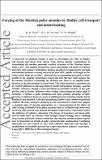Forcing of the Martian polar annulus by Hadley cell transport and latent heating
Abstract
A hierarchy of idealized models is used to investigate the roles of Hadley cell forcing and latent heat release from carbon dioxide condensation in determining the annular potential vorticity structure of the Martian winter polar vortex. The angular momentum conserving the Hadley cell model of Lindzen and Hou with summer hemisphere heating maximum of appropriate strength and latitude produces a strong westerly jet near 60°N, which is similar in strength to the winter polar night jet on Mars. Although the corresponding potential vorticity profile in the angular momentum conserving and thermal wind regions has no annular structure resembling the Martian one, there is an implied δ‐function at the discontinuity in zonal wind. This δ‐function is smoothed out by explicit diffusion in full axisymmetric model integrations forming a partial annular structure, though a local maximum in potential vorticity at the pole persists and is further enhanced when cooling representing the polar night is included. A distinct polar minimum and clear annular potential vorticity structure are obtained, however, when an additional representation of polar latent heating is also included. Full eddy‐permitting shallow‐water model integrations confirm the basic structure obtained by the axisymmetric model and suggest a nominal value of viscosity appropriate as a representation of the effects of eddy mixing. Instability of the polar annulus leads to vacillation‐type behaviour involving eddy growth and annulus disruption, followed by re‐formation under the influence of radiative relaxation. The degree of transience and mean eddy activity both show an increase with stronger latent heating and the resulting deeper polar potential vorticity minimum, showing that mixing in polar regions may be dependent on details of polar carbon dioxide condensation. Vacillation time‐scales are also shown to vary with radiative time‐scales, but through a modification of instability growth rate rather than as a result of direct radiative restoration.
Citation
Scott , R K , Seviour , W J M & Waugh , D W 2020 , ' Forcing of the Martian polar annulus by Hadley cell transport and latent heating ' , Quarterly Journal of the Royal Meteorological Society , vol. Early View . https://doi.org/10.1002/qj.3786
Publication
Quarterly Journal of the Royal Meteorological Society
Status
Peer reviewed
ISSN
0035-9009Type
Journal article
Collections
Items in the St Andrews Research Repository are protected by copyright, with all rights reserved, unless otherwise indicated.

